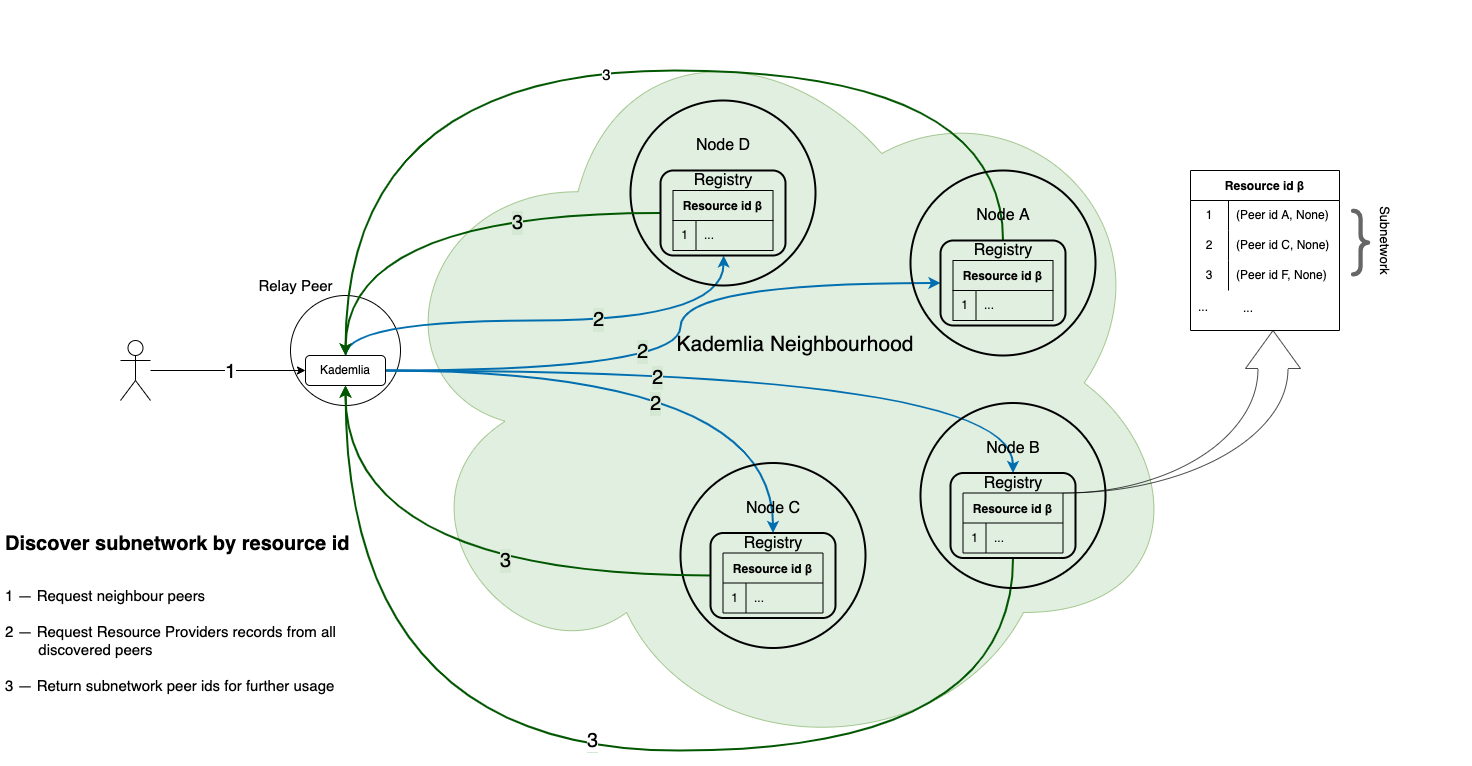There are many services in the network on different peers, and there should be a way to find and resolve these services without prior knowledge about exact identifiers. Such approach gives robustness and flexibility to our solutions in terms of discovery, redundancy and high availability.
In centralized systems, we can have centralized storage and routing, but in p2p decentralized environments, the problem becomes more challenging. Registry is our view on the solution for the problem.
Scalability, redundancy and high availability are essential parts of a decentralized system, but they are not available out of the box. To enable them, information about services should be bound with peers providing them. Also, such networks are constantly changing, and those changes should be reflected and resolvable to provide uninterruptible access. So there's a need to have a decentralized protocol to update and resolve information about routing, both global and local.
Registry is available (built-in) on every Fluence node, and it provides service advertisement and discovery. The component allows of creating relationships between unique identifiers and groups of services on various peers. So service providers can either join or disconnect anytime and be discoverable on the network.
However, Registry is not a plain KV-storage. Instead, it is a composition of the Registry service for each network participant and the scheduled scripts maintaining replication and garbage collection.
So, if you want to discover a group of services on different peers without prior knowledge, you should create a Resource. A resource is a group of services or peers united by some common feature. Please notice that resource lifetime is ~24 hours. However, if the resource has actual records, its lifetime is prolonged, and it will not be garbage-collected for the next 24 hours.
Service is represented by a combination of service_id and peer_id, it is called Record.
There is no permissions management at the moment, but in the coming updates, a resource owner will be able to provide a challenge to check against.
If you use Fluence CLI you can define dependency in fluence.yaml:
dependencies:
npm:
"@fluencelabs/registry": 0.6.2And then run fluence dependency npm i
If you are developing from scratch without Fluence CLI, you should install it via npm:
npm i @fluencelabs/registry@nightlyimport "@fluencelabs/registry/resources-api.aqua"
import "@fluencelabs/registry/registry-service.aqua"
func myFunction(resource_id: string) -> ?[]Record, *Error:
result, errors <- resolveResource(resource_id, 2)
<- result, errorscreateResource(label: string) -> ?ResourceId, *Error
Let's register a resource with the label sample by INIT_PEER_ID:
func my_resource() -> ?ResourceId, *Error:
id, errors <- createResource("sample")
<- id, errorslabelis a unique string for the peer id- creation is successful if a resource id is returned
*Erroraccumulates errors from all the affected peers
For now there is no method for Resource removal but it can be expired and garbage-collected if it doesn't have any actual records. In the future updates it can be changed.
registerService(resource_id: ResourceId, value: string, peer_id: string service_id: ?string) -> bool, *Error
Let's register a local service greeting and pass a random string hi as a value:
func registerLocalService(resource_id: ResourceId) -> bool, *Error:
success, errors <- registerService(resource_id, "hi", INIT_PEER_ID, ?[greeting])
<- success, errorsLet's register a service echo hosted on peer_id and pass a random string like sample as a value:
func registerExternalService(resource_id: ResourceId, peer_id: PeerId) -> bool, *Error:
success, errors <- registerService(resource_id, "hi", peer_id, ?[greeting])
<- success, errorsvalueis a user-defined string that can be used at the discretion of the user- to update the service record, you should register it again to create a record with a newer timestamp
- service record will be automatically updated till deleted via
unregisterService
func unregisterService(resource_id: ResourceId, peer_id: PeerId) -> bool, *Error:
Let's remove a service record from a target node:
func stopProvideExternalService(resource_id: ResourceId, peer_id: PeerId):
unregisterService(resource_id, peer_id)- it will be removed from the target node and eventually from the network
resolveResource(resource_id: ResourceId, ack: i16) -> ?[]Record, *Error
Let's resolve all service records for our resource_id:
func getMyRecords(resource_id: ResourceId, consistency_level: i16) -> ?[]Record, *Error:
records, error <- resolveResource(resource_id, consistency_level)
<- records, errorackrepresents a minimal number of peers that requested for known records
executeOnResource(resource_id: ResourceId, ack: i16, call: Record -> ()) -> bool, *Error
func callProvider(r: Record):
-- topological move to a provider via relay
on r.metadata.peer_id via r.metadata.relay_id:
-- resolve and call your service on a provider
MyService r.metadata.service_id!
MyService.do_smth()
-- call on every provider
func callEveryone(resource_id: ResourceId, ack: i16) -> bool, *Error:
success, errors <- executeOnResource(resource_id, ack, callProvider)- it is a combination of
resolveResourceand aforloop through records with the callback execution - it can be useful in case of broadcasting events
Resources with corresponding records and tombstones are automatically and periodically replicated to the Kademlia neighborhood of resource_id.
You can redefine INITIAL_REPLICATION_FACTOR and CONSISTENCY_LEVEL. The first constant is used to define the number of peers to which data will be replicated during the API call. This constant doesn't affect the network-wide replication factor, which is defined by Kademlia. The second constant defines the minimal number of peers requested to obtain the data.
Discover services without prior knowledge about exact peers and service identifiers.
A service provided by several peers still will be available for the client in case of disconnections and other providers' failures.
You can register a group of peers for a resource (without specifying any services). So you "tag" and group the nodes to create a subnetwork.
If you have a list of service records updated in runtime, you can create a load-balancing service based on your preferred metrics.
Resources API is defined in the resources-api module. Service API is defined in the registry-service module. For the details, check out API Reference.




